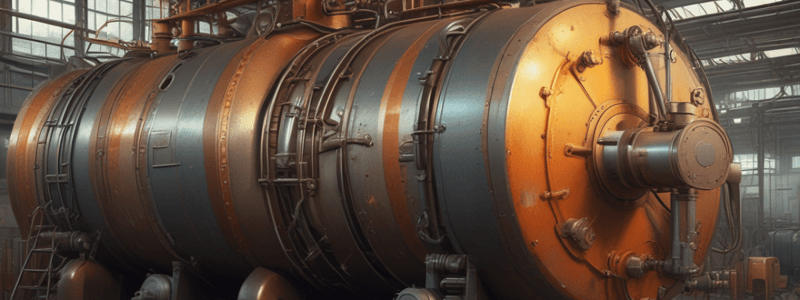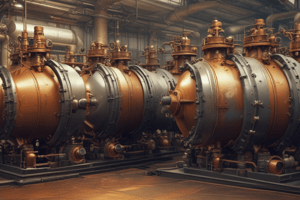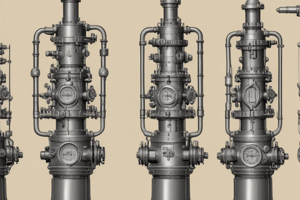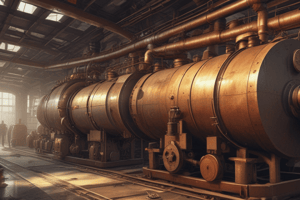Podcast
Questions and Answers
EASY What should be done before opening the boiler waterside for maintenance or inspection?
EASY What should be done before opening the boiler waterside for maintenance or inspection?
- Open the fireside access
- Turn off the circulator pump
- Close the valve in the line that connects the boiler with the expansion tank (correct)
- Drain the boiler
Why is it beneficial to keep the heating system and boilers full of chemically treated water during layup?
Why is it beneficial to keep the heating system and boilers full of chemically treated water during layup?
- To minimize chemical use (correct)
- To introduce impurities to the heating system
- To reduce make-up water usage
- To increase corrosion during the layup period
What should be done to the boiler after it has been removed from service?
What should be done to the boiler after it has been removed from service?
- Drain the boiler immediately
- Let the boiler cool down slowly (correct)
- Re-start the circulator pump
- Open the fireside access
What is the purpose of washing the boiler with a stream of high-pressure cold water?
What is the purpose of washing the boiler with a stream of high-pressure cold water?
Why is it important to perform accurate water testing and add chemicals prior to shutting off the boiler?
Why is it important to perform accurate water testing and add chemicals prior to shutting off the boiler?
What should be done with the draft fan damper if the fireside is re-closed after cleaning?
What should be done with the draft fan damper if the fireside is re-closed after cleaning?
What is the purpose of applying oil to the fireside surfaces?
What is the purpose of applying oil to the fireside surfaces?
What should be done to the stop valves in the boiler supply and return lines when shutting down the heating system?
What should be done to the stop valves in the boiler supply and return lines when shutting down the heating system?
What is the first step in taking a hot water boiler out of service?
What is the first step in taking a hot water boiler out of service?
Why is it necessary to check the automatic make-up water system?
Why is it necessary to check the automatic make-up water system?
What should be done if the flame is irregular?
What should be done if the flame is irregular?
What is the purpose of testing the operating and limit controls?
What is the purpose of testing the operating and limit controls?
What is the purpose of the try lever test on the safety relief valve?
What is the purpose of the try lever test on the safety relief valve?
What should be done to the water chemistry?
What should be done to the water chemistry?
What should be done to the boiler control switch?
What should be done to the boiler control switch?
What is the final step in taking a hot water boiler out of service?
What is the final step in taking a hot water boiler out of service?
MEDIUM What is the primary purpose of assessing the boiler's overall status and condition before shutting it down?
MEDIUM What is the primary purpose of assessing the boiler's overall status and condition before shutting it down?
Why is it necessary to check the flame for irregularity before shutting down the boiler?
Why is it necessary to check the flame for irregularity before shutting down the boiler?
What is the purpose of testing the operating and limit controls during the shutdown procedure?
What is the purpose of testing the operating and limit controls during the shutdown procedure?
What should be done to the boiler control switch after reducing the firing rate of the boiler?
What should be done to the boiler control switch after reducing the firing rate of the boiler?
Why is it important to test the water chemistry before shutting down the boiler?
Why is it important to test the water chemistry before shutting down the boiler?
What should be done to the main and pilot manual fuel valves after shutting down the boiler?
What should be done to the main and pilot manual fuel valves after shutting down the boiler?
What is the purpose of the try lever test on the safety relief valve?
What is the purpose of the try lever test on the safety relief valve?
Why is it necessary to place the burner firing rate control to manual before shutting down the boiler?
Why is it necessary to place the burner firing rate control to manual before shutting down the boiler?
Why is it crucial to perform accurate water testing and add chemicals prior to shutting off the boiler?
Why is it crucial to perform accurate water testing and add chemicals prior to shutting off the boiler?
What is the benefit of keeping the heating system and boilers full of chemically treated water during a summer layup?
What is the benefit of keeping the heating system and boilers full of chemically treated water during a summer layup?
What should be done to the circulator pump when taking the heating system out of service?
What should be done to the circulator pump when taking the heating system out of service?
What should be done with the manhole covers, handhole covers, and drain plugs after draining the boiler?
What should be done with the manhole covers, handhole covers, and drain plugs after draining the boiler?
What should be done to the fireside access during the summer months?
What should be done to the fireside access during the summer months?
Why is it necessary to tag the stop valves in the boiler supply and return lines?
Why is it necessary to tag the stop valves in the boiler supply and return lines?
What should be done to the boiler after it has cooled down slowly?
What should be done to the boiler after it has cooled down slowly?
Why is it beneficial to apply oil to the fireside surfaces?
Why is it beneficial to apply oil to the fireside surfaces?
HARD What should be done to the boiler's stop valves in the supply and return lines when taking it out of service?
HARD What should be done to the boiler's stop valves in the supply and return lines when taking it out of service?
Why is it crucial to perform accurate water testing and add chemicals prior to shutting off the boiler?
Why is it crucial to perform accurate water testing and add chemicals prior to shutting off the boiler?
What should be done to the circulator pump when taking the heating system out of service?
What should be done to the circulator pump when taking the heating system out of service?
Why is it beneficial to keep the heating system and boilers full of chemically treated water during a summer layup?
Why is it beneficial to keep the heating system and boilers full of chemically treated water during a summer layup?
What should be done to the fireside access during the summer months?
What should be done to the fireside access during the summer months?
What should be done after the boiler has completely cooled down?
What should be done after the boiler has completely cooled down?
Why is it necessary to tag the stop valves in the boiler supply and return lines?
Why is it necessary to tag the stop valves in the boiler supply and return lines?
What should be done to the boiler log book after the boiler has gone off-line?
What should be done to the boiler log book after the boiler has gone off-line?
What is the primary reason for opening the blowoff or drain valve on the bottom of the boiler before shutting it down?
What is the primary reason for opening the blowoff or drain valve on the bottom of the boiler before shutting it down?
What is the purpose of checking the automatic make-up water system during the shutdown procedure?
What is the purpose of checking the automatic make-up water system during the shutdown procedure?
What is the correct sequence of events after placing the burner firing rate control to manual?
What is the correct sequence of events after placing the burner firing rate control to manual?
What is the purpose of testing the high and low gas pressure cut-offs during the shutdown procedure?
What is the purpose of testing the high and low gas pressure cut-offs during the shutdown procedure?
What should be done to the boiler draft fan circuit breaker after shutting down the boiler?
What should be done to the boiler draft fan circuit breaker after shutting down the boiler?
Why is it necessary to test the combustion air proving switch during the shutdown procedure?
Why is it necessary to test the combustion air proving switch during the shutdown procedure?
What should be done to the water chemistry after testing it during the shutdown procedure?
What should be done to the water chemistry after testing it during the shutdown procedure?
What is the purpose of checking the flame for irregularity during the shutdown procedure?
What is the purpose of checking the flame for irregularity during the shutdown procedure?
Flashcards are hidden until you start studying
Study Notes
Preparing a Hot Water Boiler for Shutdown
- Assess the boiler's condition and controls before shutting down to identify required repairs
- Open the blowoff or drain valve to remove sediment and close when the water runs clear
- Ensure the automatic make-up water system replaces the amount of water blown off
Checking Boiler Controls and Safety Features
- Test operating and limit controls, including:
- Low water cut-off
- High temperature cut-off
- High and low gas pressure cut-offs
- Flame scanner/flame failure detection devices
- Combustion air proving switch
- Manufacturer-specified controls
- Perform a try lever test on the safety relief valve
- Test the water chemistry and add chemicals as necessary to maintain correct concentration
Shutting Down the Boiler
- Place the burner firing rate control to manual and slowly reduce the firing rate
- Turn the boiler control switch to "off" when at minimum fire
- Shut, lock, and tag the main and pilot manual fuel valves
- Open, lock, and tag the boiler control circuit breaker and boiler draft fan circuit breaker
Final Steps
- Turn off the circulator pump, lock its breaker open, and tag it (if heating system is being taken out of service)
- Close and lock the stop valves in the boiler supply and return lines
- Let the boiler cool down slowly
- Record the results of all limit tests and the time the boiler went off-line in the log book
Maintenance and Inspection
- Open the fireside access and inspect the burner and refractory according to manufacturer guidelines
- Close the valve in the line connecting the boiler to the expansion tank (if shared with other boilers)
- Drain the boiler and wash it out with a stream of high-pressure cold water after cooling down
- Inspect and clean the fireside, applying oil to protect surfaces (optional)
- Re-close the fireside and ensure the draft fan damper is shut to prevent humid air from passing through the furnace
Preparing a Hot Water Boiler for Shutdown
- Assess the boiler's condition and controls before shutting down to identify required repairs
- Open the blowoff or drain valve to remove sediment and close when the water runs clear
- Ensure the automatic make-up water system replaces the amount of water blown off
Checking Boiler Controls and Safety Features
- Test operating and limit controls, including:
- Low water cut-off
- High temperature cut-off
- High and low gas pressure cut-offs
- Flame scanner/flame failure detection devices
- Combustion air proving switch
- Manufacturer-specified controls
- Perform a try lever test on the safety relief valve
- Test the water chemistry and add chemicals as necessary to maintain correct concentration
Shutting Down the Boiler
- Place the burner firing rate control to manual and slowly reduce the firing rate
- Turn the boiler control switch to "off" when at minimum fire
- Shut, lock, and tag the main and pilot manual fuel valves
- Open, lock, and tag the boiler control circuit breaker and boiler draft fan circuit breaker
Final Steps
- Turn off the circulator pump, lock its breaker open, and tag it (if heating system is being taken out of service)
- Close and lock the stop valves in the boiler supply and return lines
- Let the boiler cool down slowly
- Record the results of all limit tests and the time the boiler went off-line in the log book
Maintenance and Inspection
- Open the fireside access and inspect the burner and refractory according to manufacturer guidelines
- Close the valve in the line connecting the boiler to the expansion tank (if shared with other boilers)
- Drain the boiler and wash it out with a stream of high-pressure cold water after cooling down
- Inspect and clean the fireside, applying oil to protect surfaces (optional)
- Re-close the fireside and ensure the draft fan damper is shut to prevent humid air from passing through the furnace
Preparing a Hot Water Boiler for Shutdown
- Assess the boiler's condition and controls before shutting down to identify required repairs
- Open the blowoff or drain valve to remove sediment and close when the water runs clear
- Ensure the automatic make-up water system replaces the amount of water blown off
Checking Boiler Controls and Safety Features
- Test operating and limit controls, including:
- Low water cut-off
- High temperature cut-off
- High and low gas pressure cut-offs
- Flame scanner/flame failure detection devices
- Combustion air proving switch
- Manufacturer-specified controls
- Perform a try lever test on the safety relief valve
- Test the water chemistry and add chemicals as necessary to maintain correct concentration
Shutting Down the Boiler
- Place the burner firing rate control to manual and slowly reduce the firing rate
- Turn the boiler control switch to "off" when at minimum fire
- Shut, lock, and tag the main and pilot manual fuel valves
- Open, lock, and tag the boiler control circuit breaker and boiler draft fan circuit breaker
Final Steps
- Turn off the circulator pump, lock its breaker open, and tag it (if heating system is being taken out of service)
- Close and lock the stop valves in the boiler supply and return lines
- Let the boiler cool down slowly
- Record the results of all limit tests and the time the boiler went off-line in the log book
Maintenance and Inspection
- Open the fireside access and inspect the burner and refractory according to manufacturer guidelines
- Close the valve in the line connecting the boiler to the expansion tank (if shared with other boilers)
- Drain the boiler and wash it out with a stream of high-pressure cold water after cooling down
- Inspect and clean the fireside, applying oil to protect surfaces (optional)
- Re-close the fireside and ensure the draft fan damper is shut to prevent humid air from passing through the furnace
Studying That Suits You
Use AI to generate personalized quizzes and flashcards to suit your learning preferences.




